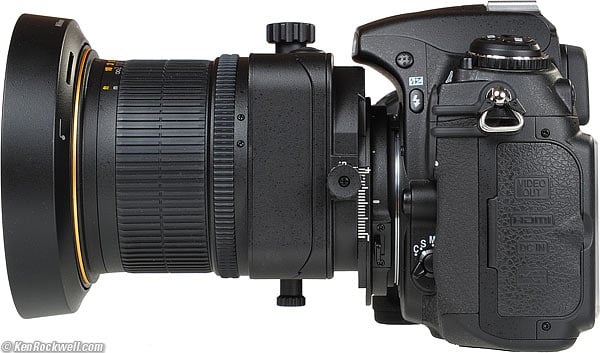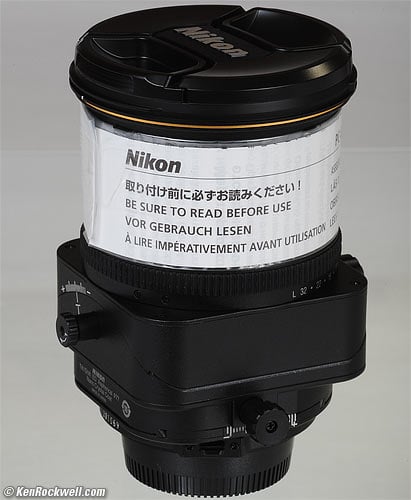Home Search Gallery How-To Books Links Workshops About Contact
Nikon 24mm PC-E Compatibility
Nikon 24mm PC-E, raised 11.5mm on a D300. Nikon 24mm f/3.5 PC-E Review More Nikon Reviews April 2008 D700 update, August 2008: The D700's flash overhangs even a little bit further than the D300's flash tested here, so the D700 will have the same, or more problems, than the D300. Introduction Nikon excused itself from its usual fanatical forwards and backwards compatibility with the 24mm f/3.5 PC-E. The only camera with which the 24mm PC-E works properly is the D3. Even though the D300 is completely compatible electronically, the D300's flash gets in the way of some movements. Below the D3 and D300, we lose automatic diaphragm control, and have to remember to press the lens's stop-down button to open and close the diaphragm for composition (open), metering (closed) and shooting (closed). Most AF cameras allow manual diaphragm control. The older AF and manual-focus cameras have no way to control the diaphragm, making the 24mm PC-E mostly useless on them. Use the classic 28mm f/3.5 PC instead. You always need to meter and then lock your exposure in the unshifted, untilted (zeroed) position with every camera. Except for the D3 and D300, which allow metering with the lens wide-open, you only get reasonably accurate metering with the 24mm PC-E stopped down. You'll get readings with the lens wide-open, but they will be very, very wrong. Sorry, Nikon gave up here; the 24mm PC-E just doesn't meter as expected with most cameras. On the D200, exposures run all over the place. Don't trust its exposure system, ever, with the 24mm PC-E. The only way to meter on the D200 is at f/3.5, and mentally convert to the shutter speed needed at the aperture you want. Then, and only then, set the smaller aperture on the lens and your manual shutter speed. On anything other than the D3 and D300 you ought to test and practice with your exposure system to be sure it's working as you intend. Of course this has always been the rule when getting any new piece of gear. Focus is easy. So long as the 24mm PC-E is opened to f/3.5, every camera's focus system, works as intended. Isn't Nikon supposed to do this experimenting for us? I spent two days trying and documenting the 24mm PC-E on every body I could borrow. Nikon owes us! I had no access to an F5, sorry F5 users. It would be helpful for next time if someone would like to send me a no-longer-needed F5.
Be careful when you try to mount the 24mm PC-E on your camera. This is the way it comes out of the box. If you get one without this warning, it's probably been used. Explanation of the terms used in the charts Mounts? Will the 24mm PC-E even mount on the camera? The FTn Photomic head of the F is so big that the lens won't fit! Rotation The angles at which you can rotate the mount of the 24mm PC-E, as seen from the shooter's position. Most cameras' prism housings gets in the way of the shift knob. Caveat: There are infinite ways to move the 24mm PC-E. These observations are for an unshifted lens. When you shift, you increase the likelihood that you'll induce additional restrictions. Manual Diaphragm Control Can the diaphragm be opened and closed with the button on the 24mm PC-E? If not, you really can't use the lens: the diaphragm doesn't work and will stay stuck wherever it was when you mounted it. If you're a hacker, you could either a.) set it to f/5.6 on an AF camera and focus, compose and shoot only at f/5.6, or b.) swap the 24mm PC-E between a second compatible AF camera to change the aperture positions between focus and shooting, or c.) if you're doing b.), then just use that camera instead! Camera Diaphragm Control Yes If the camera can control the diaphragm, you get full automation and can just shoot. You may choose the aperture on the lens (very handy), or set the 24mm PC-E's aperture ring to "L" to allow it to be set on-camera and for the camera to work in P and A exposure modes. If the camera can control the diaphragm, which only the D3 and D300 can do, you get: 1.) Automatic diaphragm control for Program and Shutter-preferred automatic exposure modes. (Lens aperture ring must be set to "L," otherwise you'll get a flashing "Fee.") In fact, you can set the lens to L and set an aperture on-camera. Now when you set the lens to L it will be at the aperture you selected on-camera, and when you place it elsewhere, you'll get the aperture on the ring. The L position becomes an aperture preset like a focus preset on long tele lenses. 2.) Full-Aperture Metering. All cameras give meter readings at full aperture, but most of them read very, very wrong. Only the D3 and D300 give accurate readings with the diaphragm open. On all cameras you must have all the movements zeroed for decent readings. 3.) The camera's Depth-of-Field preview button works. NO If you have a NO in this column, you're back in the 1850s. 1.) You set the aperture on the lens, only. (the "L" setting is the same as f/32.) 2.) There is no easy depth-of-field preview. 3.) You have to press the lens's aperture open/close button a zillion times for each shot. The diaphragm must be open to compose and to focus. It must be closed to meter and lock exposure (and metering only works well with all the moments zeroed), and closed to shoot. 4.) You only have Manual and Aperture-preferred exposure modes. 5.) Stop-down metering only. You'll see readings with the diaphragm open, but they will be very, very wrong. This is no mystery on digital, but beware on film. Max Rise The maximum vertical shift. The 24mm PC-E hits the prism housing on most cameras before it runs out of rise. Caveat: There are infinite ways to move the 24mm PC-E. These observations are for an lens with no rotation. When you rotate, other things may happen. Finder Image Blackout With the lens stopped down, most finders go black at the top when you shift the lens down. This lists the shift position below which the top of the finder goes black when the lens is stopped down. The number in (parenthesis) is what happens with the lens wide open at f/3.5. Finder blackout is rarely a problem with the lens fully open. Compatibility with Digital Cameras explanation of terms
© 2008 KenRockwell.com D80: I didn't have one on which to try the 24mm PC-E, but all signs suggest it will work identically to the D40/D70/D200. Ditto for the D100; ought to work the same, but honestly: this 24mm lives and breathes to run on full-frame. Would you really buy a Ferrari to drive around only in a parking lot? D40: You need to zero the 24mm PC-E to remove it. Otherwise the lens may hang up on the flash. Acceptable Film Cameras explanation of terms
© 2008 KenRockwell.com F4 and the others attempt Matrix metering. F4 has no in-finder aperture display with 24mm PC-E. The F4's AE-L works: if you change the aperture, the total exposure remains the same since the shutter speed changes to maintain it. You have to keep a steady hand on the F4's AEL button, since if you release it for an instant you lose your setting. If you set P mode, you get A mode but these cameras don't tell you. If you set S mode, all you'll read is HI or LO until you set the aperture on the lens the hard way, at which point you'll see the set aperture displayed on the camera. Auto ISo helps. Forget these film cameras: explanation of terms The diaphragm doesn't work on these. You can shoot, but it's not easy! The aperture reads in all of the AF cameras.
© 2008 KenRockwell.com F3HP: Lens needs to be zeroed to remove. F2AS: Very tight clearances, be careful not to scratch your DP-12 head. N2020: Sometimes the AF system gets confused and the AF motor runs!
PLUG I support my growing family through this website. If you find this as helpful as a book you might have had to buy or a workshop you may have had to take, feel free to help me continue helping everyone. If you've gotten your gear through one of my links or helped otherwise, you're family. It's great people like you who allow me to keep adding to this site full-time. Thanks! If you haven't helped yet, please do, and consider helping me with a gift of $5.00. The biggest help is to use these links to Adorama, Amazon, B&H, Ritz and J&R when you get your goodies. It costs you nothing and is a huge help. These places have the best prices and service, which is why I've used them since before this website existed. I recommend them all personally. Thanks for reading!
Ken Home Search Gallery How-To Books Links Workshops About Contact |


